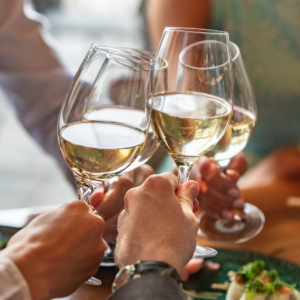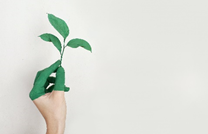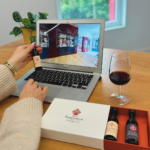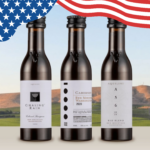The latest consumer trends and innovations in the U.S. wine industry

The U.S. wine market remains one of the largest and most dynamic globally, evolving rapidly in response to changing consumption habits and innovative marketing strategies.
For wine industry professionals, understanding these U.S. wine trends is essential to identify export opportunities and tailor their offerings to consumer preferences and evolving regulations.
Popular wine types in the U.S. & evolving preferences
Wine consumption habits in America are undergoing significant changes. In recent years, full-bodied red wines dominated sales, but we’re now seeing a strong shift toward lighter wines (whites, rosés, sparkling wines) and “cleaner” options (organic, natural, low-alcohol).
White wines surpass reds

Traditionally, full-bodied reds (often oaked and tannic) were the go-to choice for American wine drinkers. Today, the trend is reversing, with white wines steadily gaining ground and now surpassing reds in market share.
According to NielsenIQ data from May 2023, white wines accounted for 48.5% of still wine volume sales in the U.S., compared to 45.1% for reds. A year later, whites reached 49.2%, and in the most recent months, have even crossed the 50% mark.
Why are whites so popular? Younger consumers are driving this trend. They tend to prefer fresh, fruit-forward wines with vibrant acidity over the heavier tannins of traditional reds. Additionally, mid-range white wines are perceived as more consistent in quality and offer better value for money (typically $10-$20) than reds at the same price point.
The rise of rosé and sparkling wines
Whites aren’t the only wines enjoying success in the U.S. Rosés and sparkling wines are also on the rise. Rosé saw a massive boom around 2010 and has since become a staple, especially among 20- to 40-year-olds, thanks to its refreshing profile and casual, social image.
Sparkling wines, including Champagne and Prosecco, are becoming more common beyond celebrations. Prosecco, in particular, has seen explosive growth due to its festive image and affordability compared to Champagne. While Champagne still holds its luxury appeal, it has faced volume declines due to high prices and growing competition from other sparkling options.
Natural, organic, and responsible wine alternatives

Health and environmental concerns are increasingly shaping American wine choices. Organic and natural wines have gained traction. The global organic wine market reached $28.5 billion in 2022 and could grow to $69 billion by 2030, with North America playing a major role.
Natural wines — made with minimal intervention and no added sulfites — are also growing in popularity, especially among Millennials and Gen X. These consumers seek authenticity and value sustainability. Gen Z is also showing interest, drawn to the health-conscious and eco-friendly aspects of these wines.
Beyond eco-conscious trends, moderation is also a key driver. The “low & no alcohol” movement is gaining momentum, with higher-quality alcohol-free wines entering the market. These appeal to health-focused drinkers and align with the “mindful drinking” movement.
Marketing trends & innovation in the U.S. wine sector
As consumption patterns shift and competition intensifies, wine producers in the U.S. are innovating across the board: online experiences, e-commerce, sustainable packaging, digital marketing, and new distribution models are all part of a growing effort to engage a new generation of consumers.
Digitalization and the E-commerce boom

The digital transformation of the wine sector has accelerated. E-commerce wine sales surged during the pandemic and remain strong, with online alcohol sales growing from 1% to 7% of market share between 2019 and 2024.
Direct-to-consumer (DTC) models — once underestimated — have become vital revenue streams, especially for premium California wineries that now generate more income from clubs and online sales than on-site tastings.
Wineries are revamping websites, offering easy payments, loyalty programs, and mobile apps to reach wider audiences. Chatbots act as virtual sommeliers, helping customers choose wines in a few clicks.
Digital marketing is also thriving, especially SMS campaigns, which boast engagement rates 35 times higher than email. Many wineries now use SMS as a key omnichannel tool, ensuring compliance with customer consent laws.
Social media (Instagram, Facebook, TikTok, LinkedIn) is essential for connecting with Gen Y/Z consumers. Digital marketing enables personalized engagement and expands the reach of international producers seeking to enter the vast American market.
Sustainable packaging & new consumption formats
Innovation extends to wine packaging. Sustainability is a major focus, particularly among younger drinkers. Lighter, more eco-friendly formats like aluminum cans and Bag-in-Box (BiB) are gaining acceptance.
Once seen as low-end, these formats now offer strong advantages: reduced carbon footprint, better value, and suitability for on-the-go or portioned consumption. BiB formats also prevent waste by keeping wine fresh for weeks. One study showed a 3L BiB cuts carbon emissions by 84% compared to four glass bottles.

Another format gaining traction is Vinottes — mini bottles (2, 4, or 5 cl) made of recyclable PET, resealable, and shatterproof. Created by Vinovae, they offer a convenient way to taste wine anywhere. Available to U.S. wine clubs via e-tasting.com, they are gaining popularity worldwide.
Mini-formats and cans cater to consumers who want “just one glass” without opening a full bottle. These options offer practicality and align with modern, eco-conscious lifestyles.
Conclusion: A market full of opportunities for international producers
In conclusion, the U.S. wine market in 2024-2025 is entering a new phase. Consumers are seeking lighter, greener, and more innovative wines, while the industry reinvents itself through digital marketing and sustainable practices.
For international wine professionals, these trends represent major opportunities. There is growing demand in the U.S. for white, rosé, sparkling, and organic wines — a perfect fit for producers from Europe and beyond looking to expand.
That said, new tariffs and trade barriers may present challenges, so it’s important to stay informed and agile.
Marketing-wise, success in the U.S. means investing in digital channels, building strong brand storytelling, offering sustainable products, and focusing on customer experience. A strong online presence and tailored messaging aligned with local values (health, environment, convenience) are essential to stand out.
In short, the U.S. remains a wine market rich with opportunity — for those ready to adapt and innovate.




